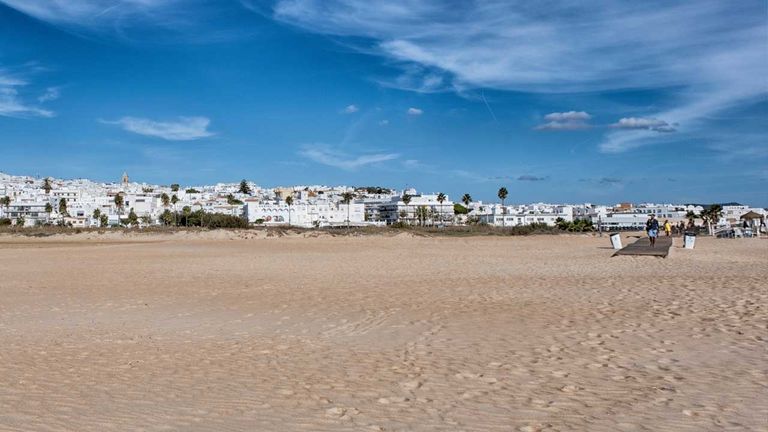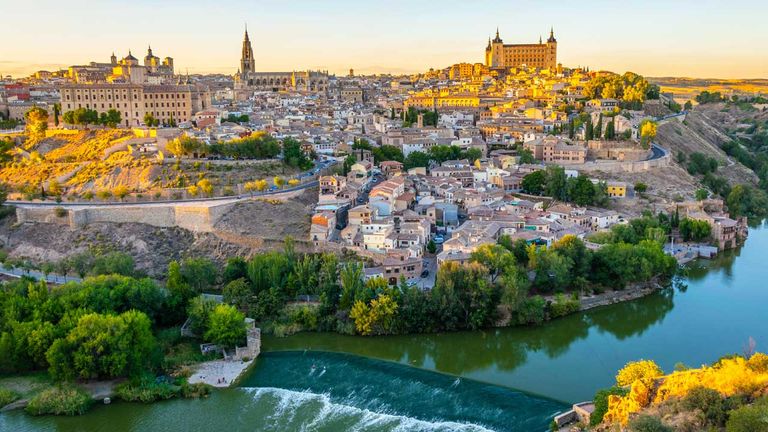Spain — which already ranks as the second-most popular destination globally (following France) on the World Tourism Barometer from U.N. Tourism — set a new record last year. The country welcomed 94 million international tourists in 2024, up from 83.5 million from 2023.
It’s no wonder why tourism accounts for more than 12% of the country’s gross domestic product. Spain is tapas territory. Jamon heaven. A paradisiacal place of paella and patatas bravas. With everything from flamenco, football, sun and surf to art, architecture and cultural and historic heritage, Spain has something for everyone.
While most tourists crowd the cobblestoned corners of cities such as Barcelona, Madrid and Sevilla, or swarm sunny Spanish islands like Ibiza, Mallorca and Tenerife, there’s a lot more to Spain than its already deluged destinations.
 La Palma in the Canary Islands is a great dupe for Spain’s more popular islands.
La Palma in the Canary Islands is a great dupe for Spain’s more popular islands.
Credit: 2025 engel.ac/stock.adobe.com
Here are a few attractive alternatives — destination dupes, if you will — that offer clients the experiences they seek, sans the seas of people.
Destination Dupes in Northern Spain
Cantabria
While the streets of San Sebastian and Bilbao in Basque Country are packed with people coming for the beautiful beaches and Michelin-starred restaurants (and the famous cheesecake at La Vina), the northern region of Cantabria offers the same renowned gastronomy and vivacious views without the same crowds.
Santander, for example, is a port city set along the Bay of Biscay that features the Cabo Mayor lighthouse and El Sardinero Beach — but Cantabria itself is home to 60 beaches, giving clients plenty of space to spread out. Visitors to the region can also explore its prehistoric caves — such as the UNESCO World Heritage Site of Altamira (often called the Sistine Chapel of prehistoric art) — and various monuments along the area's Camino de Santiago pilgrimage route. Farther inland, Picos de Europa National Park offers nature enthusiasts a variety of reserves.
Galicia
West of Cantabria, there’s the Galicia region, including its capital of Santiago de Compostela — the alleged burial place of Biblical apostle St. James, as well as the end of the well-trodden Camino de Santiago route. The streets of the capital’s UNESCO-recognized Old Town are filled with Romanesque, Renaissance, baroque, Gothic and neoclassical homes that hold secrets of the city's storied history.
Destination Dupes in Southern Spain
Andalucia
The region of Andalucia makes up all of southern Spain, famous for its year-round sunny skies and seafood. Cities such as Seville and Granada attract most of the international tourism to the area, along with other popular places like Malaga, Marbella and Tarifa. But all along the coast are hidden gems and historic havens, from Bolonia and Conil de la Frontera to Cadiz, the capital of the Province of Cadiz.
Bolonia, for example, is a small former fishing and farming village that hugs that coastline. There, clients will find Baelo Claudia, one of the region’s most well-preserved Roman archaeological sites. Bolonia is also a popular windsurfing spot — which makes sense, given its proximity to Tarifa, which is primarily known as a destination for wind sports.
 Conil de la Frontera’s white-washed buildings
Conil de la Frontera’s white-washed buildings
Credit: 2025 Patricia/stock.adobe.comConil de la Frontera, meanwhile, is more well-known for surfing. With white-washed villages and cliffs, coves and sandy beaches as far as the eye can see, the town attracts swell-seekers and van campers who come to the coast to soak in the Spanish sun. It’s also not far from Cadiz, considered one of the oldest continuously inhabited cities in Europe. Old Town Cadiz spoils visitors for their choice of high-end restaurants and cervecerias alike that offer specialties such as regional red tuna, tapas and gazpacho.
Destination Dupes on the East Coast
Comunitat Valenciana
Swap the bustling international city of Barcelona on Spain’s eastern coast for Valencia, located about 4 hours south by car. Nestled in the region of Comunitat Valenciana (Valencian Community), Valencia features the 13th-century Valencia Cathedral and La Capilla del Santo Caliz (Chapel of the Chalice), which houses the “Holy Grail” — a chalice (and Vatican-recognized relic) that is believed to have been used by Jesus Christ during the Last Supper. The cathedral’s museum also houses famous artwork by Maella and Goya, and visitors would be remiss not to climb the Gothic-style El Miguelete tower for expansive views of the city.
Located in the Barrio del Carmen district in the historic city center, where thousands of years of history come alive, the Church of San Nicolas de Bari and San Pedro Martir — considered the Valencian Sistine Chapel — is also a must-see. For a more modern experience, the Ruzafa neighborhood is flocked with beautiful bakeries and buzzing bars, cozy cafes and crawling clubs, and vintage stores and vinyl shops. And Valencia’s beaches are just a short bus ride away from the city center, where visitors will find tons more dining and nightlife.
Alicante is another can’t-go-wrong option in Comunitat Valenciana. The city’s picturesque coastline is peppered with ports and historic landmarks such as the Santa Barbara Castle. The steep climb to the castle is worth the sweeping views of the Mediterranean coast, but for different views, there are tons of craggy cliffs to explore — both outside and inside. The Canelobre Caves, for example, are teeming with tons of speleothems (geological formations made by mineral deposits, such as stalactites and stalagmites). It’s no wonder Alicante is considered a climber’s paradise.
Central Spain Destination Dupes
Castilla–La Mancha
Most visitors to Central Spain head to Madrid, a major museum city and home to the famous football team, Real Madrid. But there are other destinations to discover in central Spain outside of the Comunidad de Madrid region. For example, Toledo is a tiny town — and another UNESCO World Heritage Site — in the region of Castilla–La Mancha. Toledo is recognized as “the city of three cultures,” with a mix of Muslim, Christian and Jewish heritage. Clients will come across medieval Arab, Christian and Jewish monuments inside the walled city, just through the Moorish Bisagra Gate that opens into the old quarter.
 Toledo is called "the city of three cultures."
Toledo is called "the city of three cultures."
Credit: 2025 dudlajzov/stock.adobe.com
Castile-Leon
Nearby in the region of Castile-Leon is Avila, known for its well-preserved city walls and the Romanesque Basilica of San Vicente. For a bit of a bigger city experience, Salamanca is home to the Universidad de Salamanca, one of the oldest universities in Europe and one of the first in the world to accept female students. And Segovia is known for its Romanesque churches and the ancient Roman aqueduct of 160 arches.
Spanish Island Destination Dupes
Canary Islands
Instead of Spain’s party islands — such as the Balearic Islands of Ibiza or Mallorca, full of high-end resorts, luxury shops and world-renowned nightlife —check out the quieter Canary Islands, which float just off the west coast of Africa. While Tenerife and Gran Canaria are already well-known amongst expats and digital nomads, in particular, the islands of Lanzarote, Fuerteventura, La Palma or even El Hierro have plenty to offer without plenty of people around.
Lanzarote, for example, is known for its volcanic landscapes and Timanfaya National Park, while Fuerteventura is characterized by white-sand beaches that beckon kitesurfers and windsurfers. While La Palma is lesser known, it is known as “the beautiful island” thanks to its lush green forests and seemingly ceaseless hiking trails. Meanwhile, El Hierro is the smallest of the Canary Islands (and one of the least-frequented bits of the bunch), but it’s a go-to for divers and travelers interested in eco-tourism. Travelers will find all the same sun-swathed beaches without tripping over a grid of towels or maze of umbrellas. And they’ll get a greater diversity of nature thanks to the kaleidoscopic combination of verdant forests, volcanoes and black beaches.